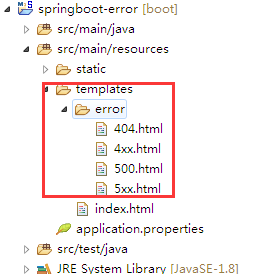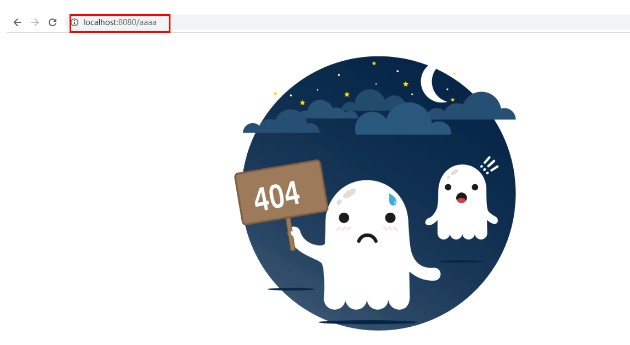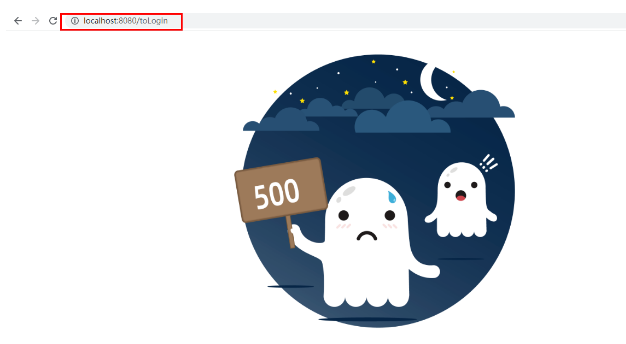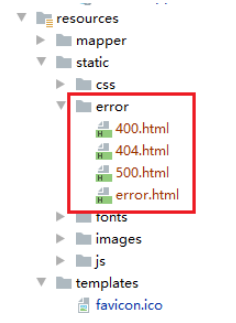本篇内容介绍了“springboot怎么自定义404、500错误提示页面”的有关知识,在实际案例的操作过程中,不少人都会遇到这样的困境,接下来就让小编带领大家学习一下如何处理这些情况吧!希望大家仔细阅读,能够学有所成!
springboot 默认的异常处理机制
springboot 默认已经提供了一套处理异常的机制。一旦程序中出现了异常 springboot 会向 /error 的 url 发送请求。在 springboot 中提供了一个名为 BasicErrorController 的类来处理 /error 请求,然后跳转到默认显示异常的页面来展示异常信息
使用模板引擎
在使用 thymeleaf 等模板引擎时,springboot 会自动到 src/main/resources/templates/error/,文件夹下寻找 404.html、500.html 的错误提示页面
错误提示页面的命名规则就是:错误码.html,如 404 是 404.html,500 是 500.html
使用示例
创建 springboot 项目如下
404、500 错误提示页面结构如下

application.properties 项目配置文件
server.port=8080#它的默认值就是classpath:/templates/,源码在ThymeleafProperties类中spring.mvc.view.prefix=classpath:/templates/#它的默认值就是.html,源码在ThymeleafProperties类中spring.mvc.view.suffix=.htmlspring.thymeleaf.cache=false404 页面内容如下
<!DOCTYPE html><html lang="en" xmlns:th="http://www.thymeleaf.org"><head> <meta charset="UTF-8"> <title>404</title> <link rel="shortcut icon" type="image/x-icon" th:href="@{/img/favicon.ico}" rel="external nofollow" rel="external nofollow" /> <link rel="stylesheet" type="text/css" th:href="@{/css/404.css}" rel="external nofollow" /></head><body><div id="banner" ></div></body></html>500 页面内容如下
<!DOCTYPE html><html lang="en" xmlns:th="http://www.thymeleaf.org"><head> <meta charset="UTF-8"> <title>500</title> <link rel="shortcut icon" type="image/x-icon" th:href="@{/img/favicon.ico}" rel="external nofollow" rel="external nofollow" /> <link rel="stylesheet" type="text/css" th:href="@{/css/500.css}" rel="external nofollow" /></head><body> <div id="banner" ></div></body></html>controller 如下
@Controllerpublic class PageController { // 跳转到登录页 @GetMapping(path = "/toLogin") public String toLogin() { int code = 1/0; return "login"; }}404.html 页面测试
访问不存在的接口:http://localhost:8080/aaaa,结果如下

500.html 页面测试
访问已存在的接口:http://localhost:8080/toLogin,结果如下

没有使用模板引擎
如果没有使用 thymeleaf 等模板引擎时,springboot 会到静态资源文件夹寻找 404.htm、500.html的错误提示页面,命名同上。springboot 中默认的静态资源路径有 4 个,分别是
classpath:/METAINF/resources/classpath:/resources/classpath:/static/classpath:/public/
优先级顺序为:META-INF/resources > resources > static > public,以上 4 种路径创建 error 文件夹,再创建 404、500 错误提示页面如下

不用写额外的映射器,就能直接请求到
“springboot怎么自定义404、500错误提示页面”的内容就介绍到这里了,感谢大家的阅读。如果想了解更多行业相关的知识可以关注编程网网站,小编将为大家输出更多高质量的实用文章!




